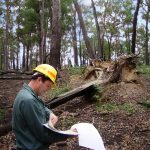Thanks to the contributions of everyone involved in the projects below, updated qualifications and skills standards will soon be available to support career pathways, safety practices, and high level forestry skills.
The final draft qualifications, skill sets and units have undergone an edit and equity and quality assurance process and are currently being reviewed by the state training authorities (STAs). They will then be forwarded to the the Australian Industry and Skills Committee (AISC) and State and Territory Ministers for consideration and endorsement. Once endorsed, the updated skills standards will be published on the National Training Register (training.gov.au).
Entry Level Forestry Skills Project
Attracting and training new entrants is a key focus for the forestry industry, as it works to find sustainable ways to keep up with continued high demand for forest and wood products.
Industry feedback has informed updates to entry level qualifications, skill sets and units so that they are more efficient and accessible to deliver and provide visible career pathways for school students, new entrants and existing workers.
For more information, visit the project page.

High-Level Forestry Skills Project
High level skills in management, supervision and planning are needed to growing sustainable forests for timber, wood and fibre products.
The skills for working with new technology and data have been captured in updated qualifications and skills standards, describing skills to optimise forest management practices, improve forest health and wood flow outcomes, and to promote safe work practices.
For more information, visit the project page.

Remote Forestry Operations Project
Strong safety skills are required to work in the forestry industry, particularly when operating in remote locations.
Thanks to everyone who contributed to this project, two units have been developed to describe the skills and knowledge required to apply situational awareness and a safety mindset while working in team situations or alone in remote areas.
For more information, visit the project page.

